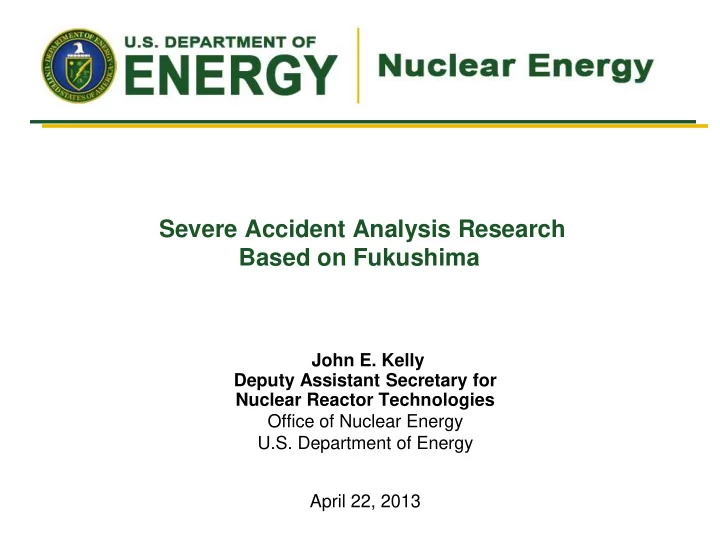

Severe Accident Analysis Research Based on Fukushima John E. Kelly Deputy Assistant Secretary for Nuclear Reactor Technologies Office of Nuclear Energy U.S. Department of Energy April 22, 2013
Joint DOE-NRC MELCOR reconstruction of Fukushima Daiichi Accident Scope of Effort Collect and archive data on accidents (portal) Reconstruct accidents Assess validity of MELCOR models Sandia-led effort with INL and ORNL SOARCA Mark-I MELCOR model used as starting point to reconstruct accidents Collaboration with and peer review by NRC, JNES, TEPCO, EPRI Report published in August 2012 2
Comparison of MELCOR Unit 1 Analysis of RPV and Containment Pressures 3
Unit 1 Results – Refueling Bay Vapor/Gas Molar Concentrations Gas Composition in Refueling Bay 1 0.1 mole fraction steam oxygen hydrogen 0.01 carbon monoxide H2 + CO max steam min O2 min H2/CO 0.001 10 15 20 25 30 time [hr] 4
Predicted Cesium Release at 1F1 Radiation monitors at front gate jump at ~15 hr Cs Environmental release about 400,000 Ci 5
MELTSPREAD & COREQUENCH Best-estimate Ex-Vessel analysis of Unit 1 1F1 ex-vessel behavior using best estimate codes for spreading (MELTSPREAD) and debris coolability (CORQUENCH) MELCOR and MAAP melt pour conditions used as input MELTSPREAD calculates extent of spreading and shell heat-up COREQUENCH evaluates coolability of debris Predictions support TEPCO planning for 1F1 disassembly Principal results: Axial ablation of the concrete below the reactor vessel predicted to be up to 60 cm out of a total thickness of 140 cm in the most extreme case While there was significant concrete ablation the debris was coolable for all scenarios 6
NEA Fukushima Daiichi Project NEA is organizing an international project on Fukushima Phase 1 is a code benchmarking study of Fukushima accident Phase 2 would be to gather data as reactors are defueled In Phase 1, numerous severe accident codes are being used to reconstruct accident and then cross-compared (MELCOR, MAAP, SAMPSON, SOCRAT, ASTEC) Objectives of this study Improve severe accident codes via benchmarking with actual data Use code results to guide planning of defueling operations Participating Countries Include: US, Switzerland, Spain, France, Russian, Germany, Korea, France & Japan Phase 2 is under discussion Program similar to post-TMI project is being considered DOE conducting uncertainty quantification study to aid 7
DOE December 2012 Visit to Fukushima DOE team on top of Unit 4 Kelly peering into Spent Fuel Pool Aftermath of H 2 explosion 8
Recommend
More recommend